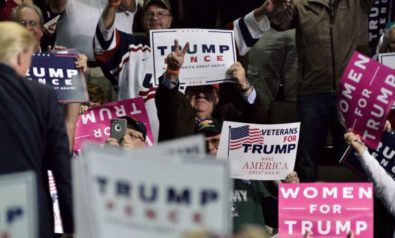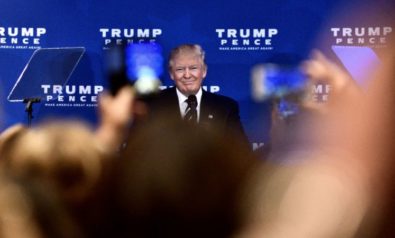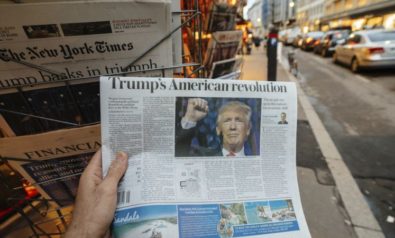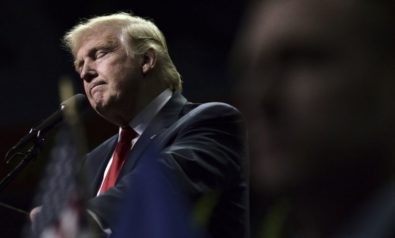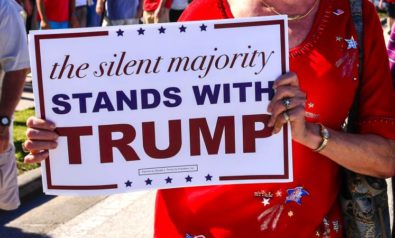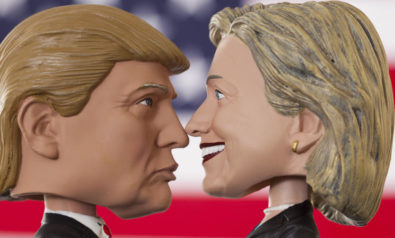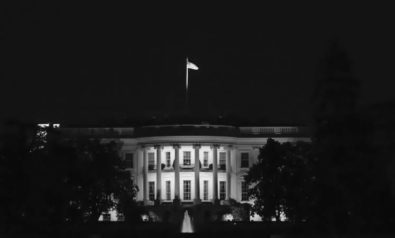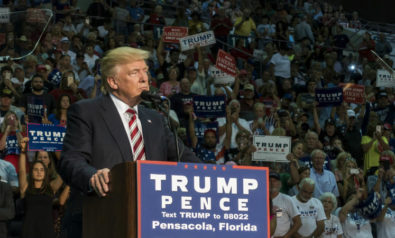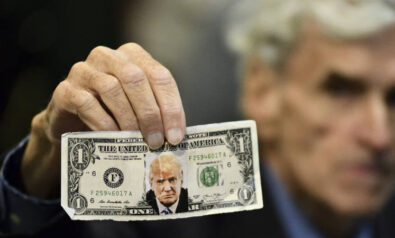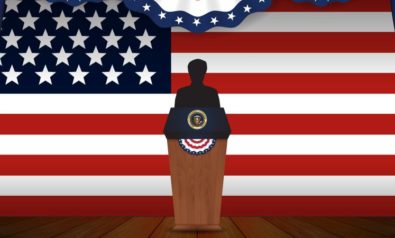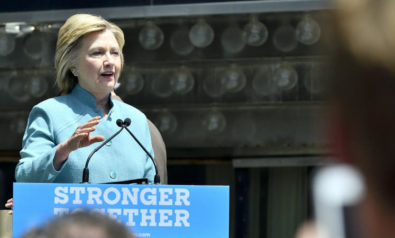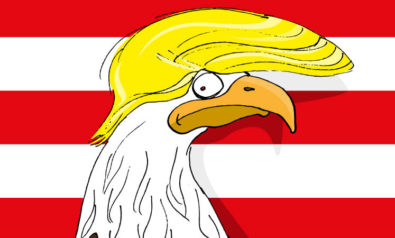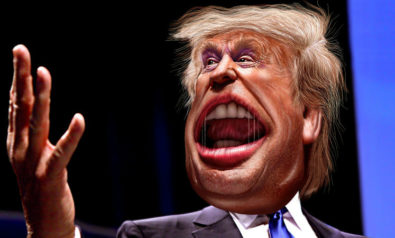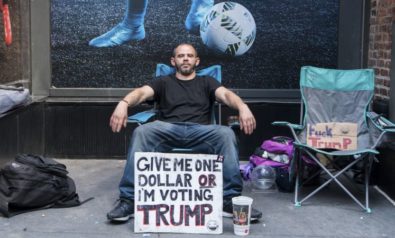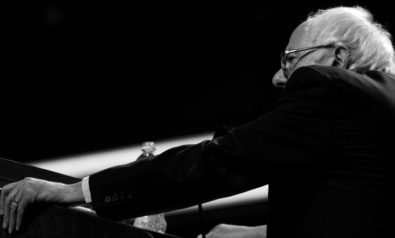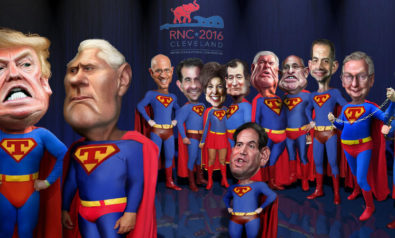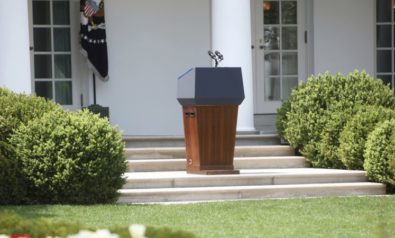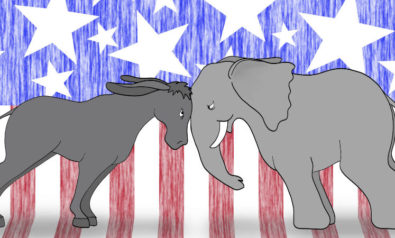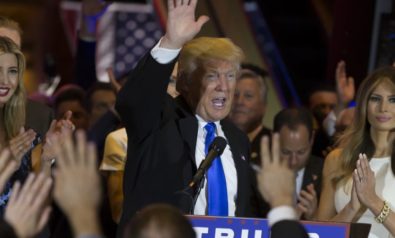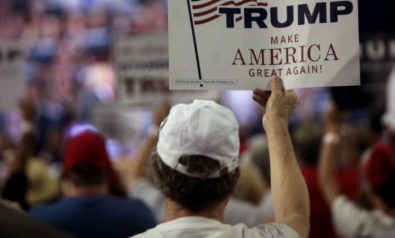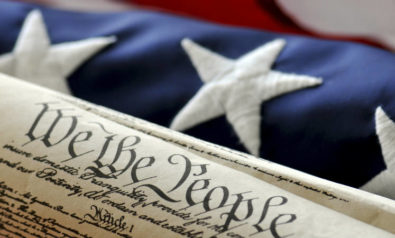If candidates have become commodities, voters have become passive consumers.
Donald Trump began his rise in June 2015 by descending an escalator while boldly introducing a new degree of vulgarity and bigotry into presidential political discourse. Clothed in the armor of what the public took to be frank discourse, over the next 12 months he engaged in a series of mortal jousts with rival Republican knights, vanquishing more than a dozen opponents, each mounted on their official Republican Party steed.
After which, surrounded by his family at the July convention, he became the lonely but fearless leader of a party that mourned its dead in the absence of its surviving but ailing champions, about to venture forth to complete his heroic crusade. It would lead him to face off against the invincible Knightess of the Democrats, whose armor had been honed by the world’s most experienced and renowned political smiths. Her only known weakness, as some had discovered, was the eventual frailty of her mail.
Then, just when all seemed lost as his past sins were revealed before being confessed in public, he achieved a resounding victory that placed him on the coveted throne at the White House, gainsaying the divinations of the political seers and wizards who had predicted the triumph, foreordained by the stars of Washington and Hollywood, of the Knightess Hillary.
Presidential Thrones
This imaginary telling of a contemporary game of presidential thrones is one way of summarizing the story the entire world is now acquainted with. It’s the story of a successful 16-month quest, expurgated of course of many of the less recommendable episodes concerning multiple damsels in distress, outrageously formulated prevarications, tax write-offs and various insalubrious and violent incidents. It was a drama clearly written for an agonizing empire, the land of the ailing Fisher King, protector of the Holy Grail, longing to bring back the prosperity of the past to a land gone hopelessly arid.
In the age of cable television, many of us count on dramatized stories to provide us with the means to understand both the past and the present.
The surreal drama of politics in America
The founders of American democracy designed their political system to give informed citizens a voice in the affairs of their government, and the power to select those who would have the dual task of translating their needs into law and representing their point of view in the national dialogue. Most—with the possible exception of strict constructionists—will admit that a lot has changed since the drafting of the Constitution.
In the age of powerful print and audiovisual media that facilitate the easy creation and circulation of cultural memes, democracy has long since succumbed to the logic elaborated by Guy Debord, the French theorist, in his book Société du Spectacle, published nearly 50 years ago. Debord describes a society that has transformed social relations from a state of being (living directly) to having (acquiring and possessing), and from having to appearing, in the form of a spectacle, as an object that can be consumed in the moment and discarded.
The phenomena he described in that book were only just emerging, but they have increasingly dominated the political landscape ever since. Some say it began with the televised John F. Kennedy Richard Nixon debates, in which the image of the candidates had a far greater impact on the election results than the positions the candidates expressed during the debate. Madison Avenue immediately sensed an opportunity and thus began the era of “scientific” political marketing orchestrated by the new generation of Mad Men. Ten years after Kennedy, Jess Unruh, a traditional politician informally dubbed the “kingmaker,” famously complained that Ronald Reagan, his opponent for the office of governor of California in the 1970 election, was packaged “like a bar of soap.”
If candidates have become commodities, voters have correspondingly become passive consumers. They are expected to do nothing more than commit to a product presented to them through the media. Because of the two-party system that has dominated American politics for nearly two centuries, voters understand that the choice of the product will always be presented in the simplest possible terms, as an option between product A and product B.
Armed with the foreknowledge of this fatally binary logic that applies to every political campaign, the marketers could get to work modeling, sculpting and packaging their political products—the candidates. In the list of ingredients on the package, they are always careful to include some “big ideas,” one or two “ideals” and an example or two of the “original thoughts” of their product-candidate. Bundled together, these will appear as their party platform or legislative program. Like food labeling, it permits the consumer to check whether an essential policy ingredient is present or whether there’s an industrial chemical to be avoided.
But unlike food products, marketers cannot simply put their merchandise in stores, launch some advertising and expect people to buy and consume it. Because elections are about citizens exercising democracy and the engagement of voters in the construction of their own political history, the marketers must be able to turn the product as frequently as possible into “news.” They must create the belief that their candidate represents at least one essential theme that will be beneficial to society, and that their product will contribute to the history of the community, if not the nation.
And, of course, getting people to vote isn’t enough. The candidate must win, otherwise all is for naught. This means that beyond the packaging and advertising, the news factor has become increasingly important.
 Fair Observer provides you deep and diverse insights for free. Remember that we still have to pay for servers, website maintenance and much more. So, donate now to keep us free, fair and independent.
Fair Observer provides you deep and diverse insights for free. Remember that we still have to pay for servers, website maintenance and much more. So, donate now to keep us free, fair and independent.
Donald Trump understood this from day one, possibly because he came from the world of media and show business. But the highly professional political marketing scientists of Hillary Clinton’s campaign clearly underestimated this factor, possibly because they assumed that Hillary had a stockpile of news from the past that could be referenced at any time. In doing so, they left a clear path for Trump, news manipulator par excellence, to coast to victory.
The electoral process in the 21st century
The exceptional, authentically surreal American presidential election campaign of 2016 offers us a rare opportunity to probe how the process of 21st century electoral politics works—in particular, how the media condition and manage perception of the goods on display, aka “the candidates.”
The first thing to notice is the nature of the choice given to the consumers. At least since the Kennedy-Nixon election, the media have perfected the art of reducing presidential elections to simple popularity contests. They are complicated only by the idea that one key ingredient in the process is to incite voters not just to support, but also to identify with their chosen candidate and, in the heat of the final phase of the battle, to feel and personally react to their triumph or defeat. Clinton supporters interviewed by the media on the following morning typically said things like, “I don’t understand how we lost,” as if they were personally an integral part of the team.
Let’s take a closer look at how this identification with the industrially packaged candidate is achieved.
First, the political marketing team packages their candidate, usually following the branding norms of their party, Democrat or Republican. They thus offer the public a simple consumer choice between product A or product B. They set the scene and deliver the goods to the media, who then take over to create drama by redesigning the election according to the model of a sporting event.
From that point on, the polls will play the function of scorekeeping, while the candidates are expected to demonstrate their personal skills and political muscle by exciting crowds. This transformation into the simulacrum of a sporting event is facilitated by the fact that the two-party system ensures that every election will function as a binary opposition, and that the campaign will last for the equivalent of an entire sports season, a time scale no other Western democracy is ready to adopt.
This basic model has been in existence for decades. It works even when no serious contrast exists between the candidates other than style, level of “talent” and superficial image (including dress). The lack of fundamental contrast is in fact the norm, as there is an implicit “presidential” bearing, style and “level of seriousness.” This has been the case in all previous elections, where the Republican and Democrat presidents would be given the opportunity to differentiate themselves by promoting cultural issues linked to the official ideologies of their respective parties, while managing in virtually identical fashion the essentials: the economy and foreign policy, including the permanent expansion of the military-industrial complex that ties the two together.
Once the media had taken over the management of the drama of presidential campaigns, they would skew the story away from the issues and put the spotlight on the personalities of the two gladiators in the ring. Under the control of the marketers, the candidates would then predictably and relentlessly repeat their pet themes to their rallies and private events, “appealing to their base” and reassuring their fans.
At the same time, the media would systematically ignore or underplay the themes of their campaigns, which they treat as the inalienable intellectual property of the candidates or their parties. Instead, they would focus on testing and comparing the candidates’ respective skill sets. This process is never more evident than in the debates, which rarely produce anything resembling political insight but immediately provoke reams of commentary worthy of a sports page, dedicated to assessing who won and who lost.
It would be unthinkable that a debate should raise questions to be further explored when the media and the public assume that the whole point of it is to score points, knockdowns and, with a bit of luck, knockouts. But since there are no physical criteria for the scoring of a presidential debate, the media offer us subjective judgments about “presidential manner,” attitude and temperament. This author is particularly amused by the importance given by all the media to what’s called “fact checking,” as if it was the equivalent of counting points per round in a boxing match.
Donald Trump’s new paradigm
Up until the 2016 campaign and the emergence of Donald Trump, candidate packaging and marketing always followed the same tried and true pattern. It was designed to take place in two distinct phases.
In phase one, the marketing teams first packaged and then launched their candidates. They were fitted with campaign themes they could constantly repeat or fall back on to prove their high seriousness and mobilize their base.
Then, in phase two, the media took over the task of fabricating “news” around the campaign and then finding ways of building the drama. The campaigns themselves have generally sought to build drama not for their own candidates, but by planting or highlighting negative “news” concerning their opponent. This is the strategy the Clinton campaign used right up to the end, with a panicked acceleration in the days before voters went to the polls.
Wittingly or unwittingly, Trump did the opposite. Like Muhammad Ali in the ring, from the opening bell he came out with his guard lowered and began prancing about, from news station to news station, making himself look easily vulnerable to the attack of his opponents while at the same time appearing evasive, as if he didn’t even want to be in the ring. The young Cassius Clay knew how to upset and confuse his opponents before coming to believe, as his career advanced, that he could outbox them with his strength, speed and endurance.
One after the other, with his incessant and hyperactive footwork, especially in the Republican debates, Trump, like Ali, wore his opponents down and “proved” it by calling them “low energy.” He thus successfully eliminated the anointed champion of the Republican establishment, Jeb Bush, and then dealt summarily with Marco Rubio, Ted Cruz, Chris Christie, Ben Carson and the others. Like Joe Louis and Muhammad Ali, he raced through his “bum of the month” club and came out of the Republican National Convention with the champion’s belt. For the general election, he increased the volume of his verbal provocations not only against his opponent, but toward the public as well. He even scored a surprise knockdown when his opponent faltered and collapsed on the most symbolic of days, 9/11.
Trump turned the well-oiled two-party campaign system on its head and managed to punch his way through the long rounds of the championship fight, like Joe Louis, Rocky Marciano or Muhammad Ali. Some believe he overturned the rules because he never expected to win and didn’t really care. It remains true that instead of starting with the scientific marketing of phase one, he launched straight into the drama of phase two. Before he had a product to package—and one is left wondering whether he ever created one—Trump was not only in the news cycle, but he clearly understood how to dominate it.
Having seen the most unorthodox and surreal of candidates bully his way to victory, we must now ask ourselves two things.
First, what happens within the sophisticated global military-financial-industrial system when there’s an unorthodox, surreal captain at the helm? At this point, nobody—and least of all Donald Trump—knows the answer to that question, partly because he will not have a ring to dance around in anymore and must for the first time sit down and think it out. He will be confined to a series of tightly controlled dialogues in the Oval Office with those mostly anonymous managers who have their hands on the complex reins of global power.
The second question looks further forward into history: What does this mean for the future of presidential campaigns? Has Trump created a new paradigm and, if so, can anyone else imitate it? It may appear that he learned many of his tricks from former Italian Prime Minister Silvio Berlusconi, who was more of a distant model than a mentor. Trump may be less of an innovator than people give him credit for.
But it makes no sense to compare Italy, a political province of Europe that was never properly unified, with the United States. Trump has, in any case, possibly delivered the coup de grâce to the traditional logic and elaborate rituals of presidential campaigns in America. Unloved by the establishment figures of his own Republican Party, he has also wounded the two-party system in ways that are too early to assess.
This author has not mentioned the other key innovative factor in this campaign cycle: Bernie Sanders. Without Bernie’s unexpected and equally provocative disturbance of the process on the Democratic side, Trump may never have succeeded. Both parties were not only challenged, but seriously destabilized, possibly even fatally. Those two candidates, in radically different fashion, revealed the weakness and hypocrisy of a system built by the parties, controlled by marketing professionals and sold by the complicit media.
The views expressed in this article are the author’s own and do not necessarily reflect Fair Observer’s editorial policy.
Photo Credit: Trigger Photo
Support Fair Observer
We rely on your support for our independence, diversity and quality.
For more than 10 years, Fair Observer has been free, fair and independent. No billionaire owns us, no advertisers control us. We are a reader-supported nonprofit. Unlike many other publications, we keep our content free for readers regardless of where they live or whether they can afford to pay. We have no paywalls and no ads.
In the post-truth era of fake news, echo chambers and filter bubbles, we publish a plurality of perspectives from around the world. Anyone can publish with us, but everyone goes through a rigorous editorial process. So, you get fact-checked, well-reasoned content instead of noise.
We publish 2,500+ voices from 90+ countries. We also conduct education and training programs
on subjects ranging from digital media and journalism to writing and critical thinking. This
doesn’t come cheap. Servers, editors, trainers and web developers cost
money.
Please consider supporting us on a regular basis as a recurring donor or a
sustaining member.
Will you support FO’s journalism?
We rely on your support for our independence, diversity and quality.




